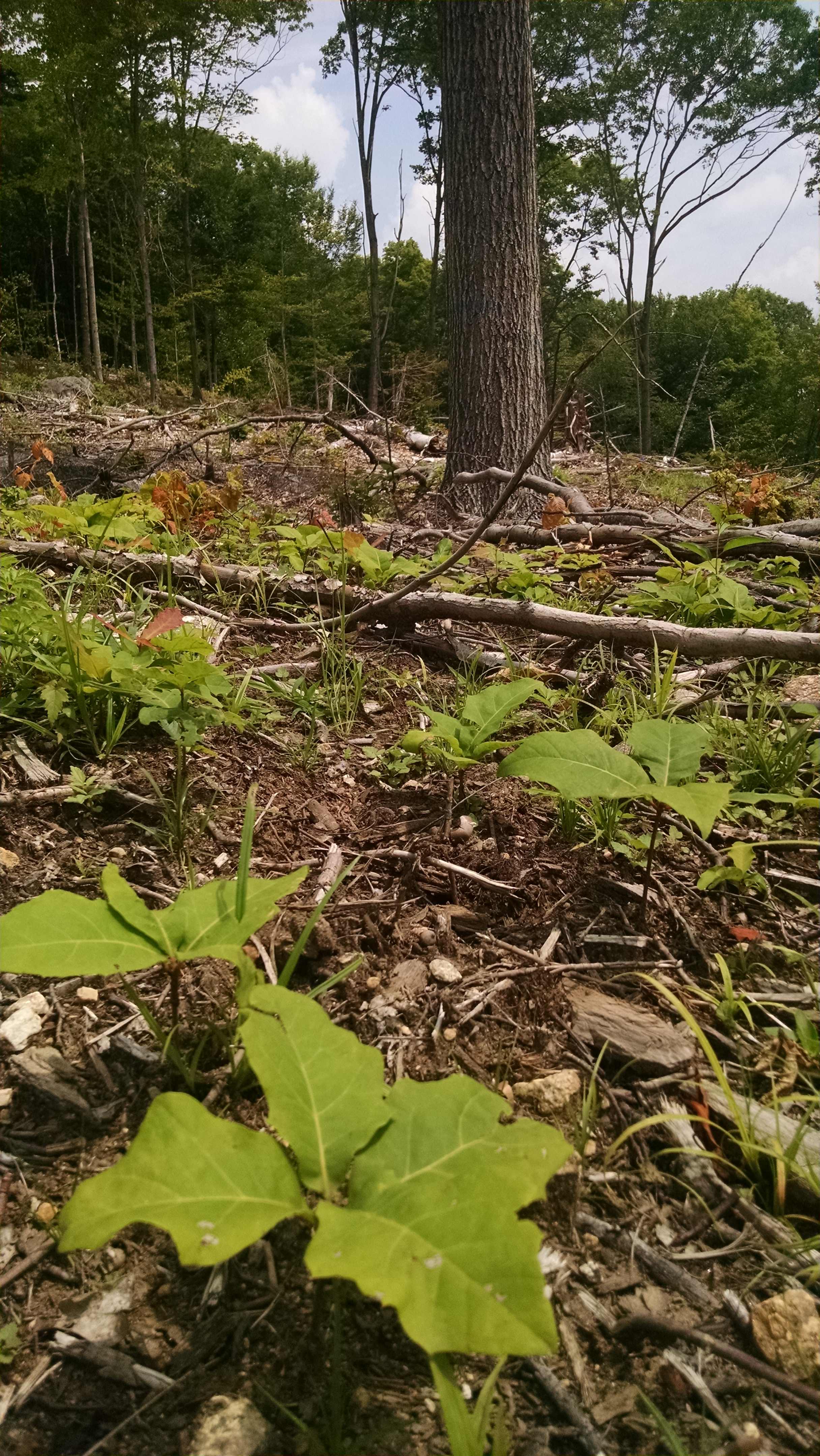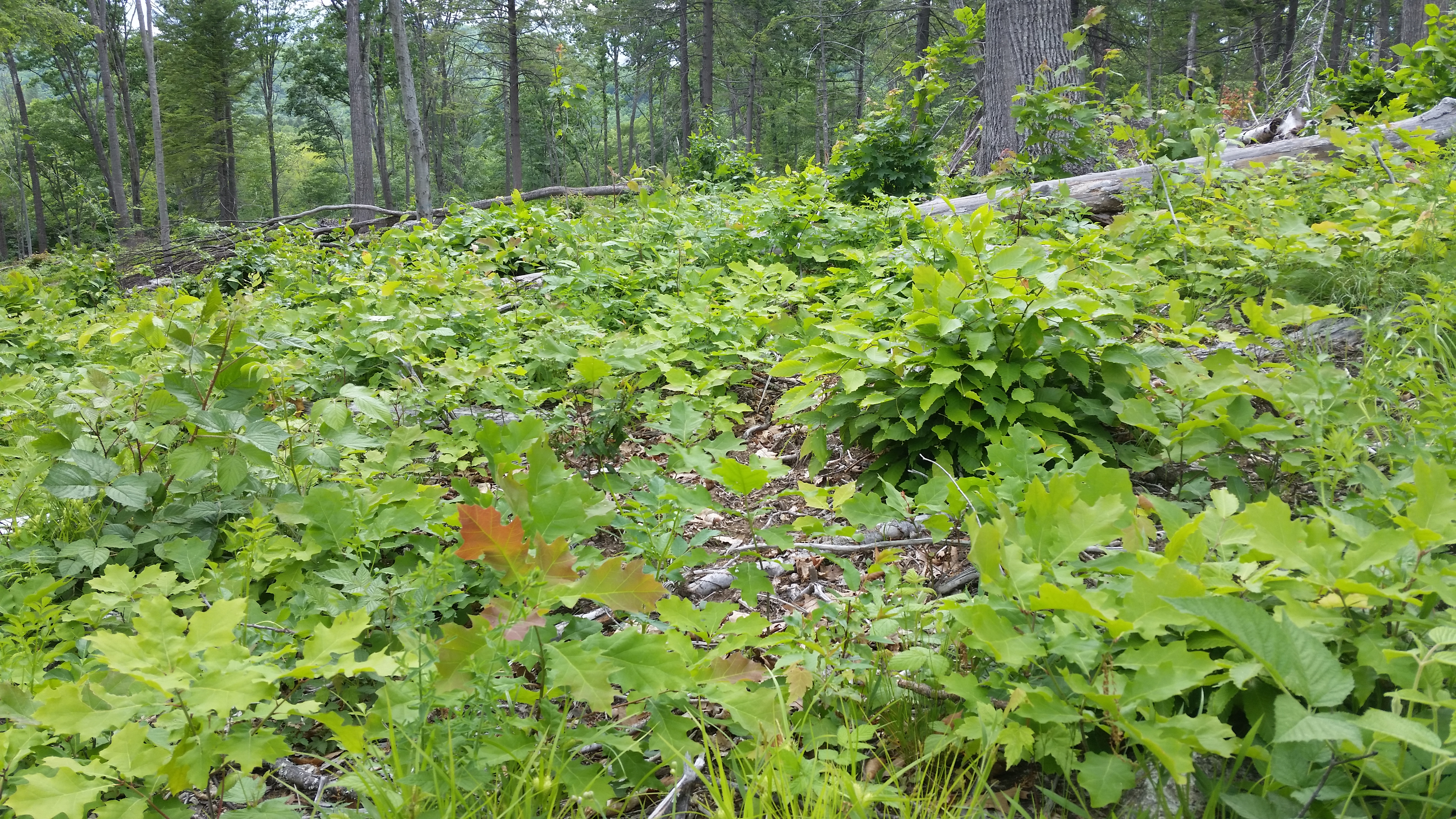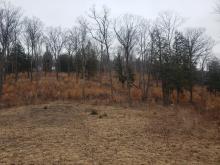Secondary tabs
Submission information
| Study Title | Oak regeneration harvest at Hope Forest in Danbury, NH |
|---|---|
| Case Study Type | Forest type |
| Site Photo |
|
| Image caption | Hardwood regeneration 7 growing seasons after harvest |
| Lay Summary | A commercial timber harvest was carried out in the fall of 2014 after an oak mast year. Prescriptions included two low-density shelterwood areas (12 and 18 acres in size), and five large group openings (1-2 acres in size). The goal was to regenerate oak along with a mixture of other desirable hardwood species. |
| Location | Danbury, New Hampshire |
| Location Description | South-facing slope with fine sandy loam soils |
| Latitude | 43.493356 |
| Longitude | -71.891636 |
| Directions | You cannot drive right to the harvest area, but parking is possible off Roy Ford Road here (https://goo.gl/maps/XmJbwNyp8MLjrtJB9) by the Forest Society property sign and gate. The access road used for the harvest is on land owned by an abutter and is not usable for the general public. From the Forest Society gate and sign, you can walk for a while on a trail, but then will need to bushwack the rest of the way to the landing and harvest areas. |
| Accessibility | by foot |
| Landowner Name | Society for the Protection of NH Forests |
| Landowner phone | +1 603-224-9945 |
| Landowner email | info@forestsociety.org |
| Stand Area with Units | 100 acres |
| Cover Type | Northern Hardwoods |
| Natural Community Classification | Semi-Rich Appalachian Oak-Sugar Maple Forest |
| Plant Community/Habitat Class Growth Stage | Prior to harvest, the forest was a mature, closed canopy stand with trees mostly in the small and large sawtimber size classes |
| Soils | Lyman-Tunbridge-Rock Outcrop complex |
| Start date | Sat, 11/01/2014 - 00:00 |
| End date | Mon, 02/16/2015 - 00:00 |
| Stand History | The entire property was once cleared and used as farmland, with the lowlands used for crops and other areas used as pasture. The property has been a registered Tree Farm since 1970. The Forest Society acquired the property in 1991, and conducted previous timber harvests in 1993 and 2008. |
| Pre-Treatment Species Composition | red oak, sugar maple, white pine, hemlock, red maple, white ash, beech, white birch, red spruce |
| Species 1 | Quercus rubra (northern red oak) |
| Species 1 Percent(%) | 37% |
| Species 2 | Acer saccharum (sugar maple) |
| Species 2 Percent(%) | 24% |
| Species 3 | Acer rubrum (red maple) |
| Species 3 Percent(%) | 9% |
| Pre-Treatment Growth Stocking | Basal area of 109 sq ft per acre |
| Case Overview | The Emily & Theodore Hope Forest is owned by the Society for the Protection of NH Forests (Forest Society), a non-profit land trust and forestry organization dedicated to protecting the state's most important landscapes while promoting the wise use of its renewable natural resources. The Hope Forest was donated to the Forest Society in 1991, and previous timber harvests were conducted in 1993 and 2008. An updated forest management plan written in 2013 was the basis for the harvest conducted in the fall of 2014. One goal of the harvest was to take advantage of the excellent red oak mast year and attempt silviculture to regenerate red oak, which grows well on the property. The Forest Society ran a timber harvest tour for the public while the harvest was active. |
| Silviculture Objectives | Multiple prescriptions were carried out: (1)Two low-density shelterwood harvests (12 and 18 acres in size) were conducted on the lower slopes nearby the landing. Mostly red oak trees were reatained, at an approximate residual basal area of 40 sq ft per acre. One goal was the regeneration of red oak. (2) Five group openings (1-2 acres in size) were conducted in the higher elevation areas, with the goal of regenerating red oak. (3) Thinning and small group selection harvesting were carried out in several other areas, with the goal of improving the residual growing stock of the stand, and encouraging desirable species and individual trees. |
| Landowner Objectives | Preserve water quality, especially that of the Beverly, Walker and Frazier Brooks, which are part of the headwaters to the Blackwater River; Protect ecologically sensitive areas located within the forest; Protect and safeguard historically significant sites within the property; Improve the commercial timber growing stock within the forest of the property; Harvest forest products when ecologically and economically appropriate; Maintain or increase the biodiversity on the property; Provide a diverse mixture of wildlife habitat; & Provide recreational opportunities for fisherman, hunters, and other passive users of the property |
| Regeneration Targets/Goals | Red oak was the primary species targeted for regeneration. We timed this harvest to coincide with a mast year for oak, with machinery driving over fallen acorns during the harvest to push them into the soil for improved germination. |
| Regeneration Method | shelterwood |
| Factors Influencing Prescription Choice |
|
| Equipment used | Cut-to-length harvester and forwarder |
| Post-Treatment Assessment Done | yes |
| Post-Treatment Assessment Expected | yes |
| Post Harvest Regeneration Monitoring Data | Low-density Shelterwood (12 & 18 acres) |
| Keyword(s) | Red oak silviculture |
| Data Available? | no |
| Primary Contact | Gabe Roxby |
| Contact Title | Field Forester |
| Contact Organization | Society for the Protection of NH Forests |
| Contact Email | groxby@forestsociety.org |
| Contact Phone | +1 603-224-9945 |
| Contact Address | 54 Portsmouth St Concord, New Hampshire. 03301 United States |
| Biography | Founded by a handful of concerned citizens in 1901, the Society for the Protection of New Hampshire Forests is now one of the country's most effective statewide land conservation organizations. Our mission statement, developed in 1904 is: "We are a forestry association seeking to perpetuate the forests of New Hampshire through their wise use and their complete reservation in places of special scenic beauty." As a non-profit membership organization, the Forest Society is dedicated to protecting the state's most important landscapes while promoting the wise use of its renewable natural resources. |
| Additional Photo 1 |

|
| Caption 1 | July 2015: oak regeneration after one growing season |
| Additional Photo 2 |

|
| Caption 2 | June 2016: red oak regeneration at the start of the second growing season |
| Additional Photo 3 |

|
| Caption 3 | May 2018: hardwood regeneration after three growing seasons, oak still dominant |
| Additional Photo 4 |

|
| Caption 4 | Hardwood regeneration after 7 growing seasons, hop hornbeam and beech dominant |
